#ulysses european odyssey
Explore tagged Tumblr posts
Text

James Joyce, Gilbert Schema, for Stuart Gilbert, (1920/1921-) ca. 1930 [ULYSSES European Odyssey (UEO), 2022-2024. Ulysses Guide / Patrick Hastings]
#manuscript#schema#handwriting#james joyce#ulysses#gilbert schema#patrick hastings#ulysses european odyssey#ulysses guide
47 notes
·
View notes
Text
Nagyregény.

[Az első amerikai kiadás borítója, 1934]
#James Joyce#Ulysses#nagyregény#Énbudapestem#Budapest Nagyregény#Budapest Nagyremény#Budapest#ULYSSES EUROPEAN ODYSSEY#Budapest Brand
0 notes
Text
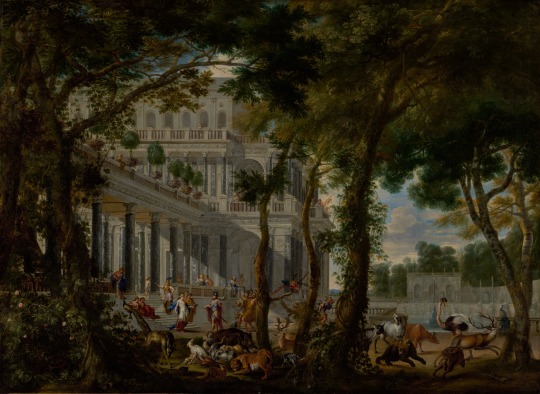
Ulysses at Circe's Palace by Wilhelm Schubert van Ehrenberg and Carl Borromäus Andreas Ruthart
#wilhelm schubert van ehrenberg#carl borromäus andreas ruthart#art#ulysses#odysseus#circe#palace#the odyssey#sorceress#witch#stairs#architecture#magic potion#animals#wild beasts#antlers#wild boar#classical antiquity#greek mythology#homer#ancient greece#ancient greek#europe#european#trees#herbal antidote#hermes#landscape#flemish#gardens
199 notes
·
View notes
Text

Marie-François Firmin-Girard (French, 1838-1921) Ulysse et les sirènes, 1864 Musée d'art et d'histoire de Narbonne
#Marie-François Firmin-Girard#Ulysse et les sirènes#1864#french art#french#france#art#fine art#european art#classical art#europe#european#fine arts#oil painting#europa#mediterranean#greek mythology#the odyssey#ulysses#brunette redhead blonde art trope#brunette#redhead#blonde#woman#women#female#female nude#western civilization#1800s
86 notes
·
View notes
Text
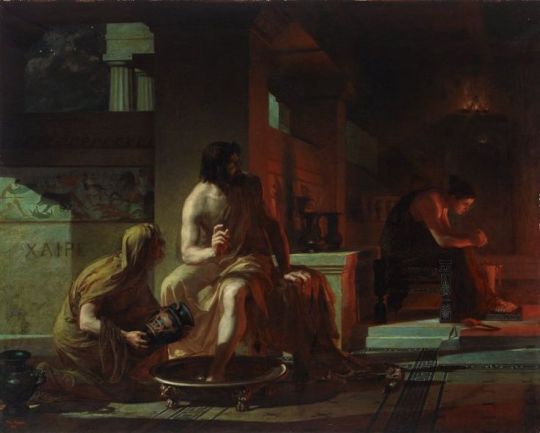
The Return of Ulysses
Artist: Frederick Trevelyan Goodall (English, 1848-1871)
Date: 1869
Medium: Oil on canvas
Collection: Art Gallery of New South Wales, Sydney, Australia
Description
The Return of Ulysses is the story of Odysseus's return home from the Trojan War in Homer's Odyssey. The story is about Odysseus' struggles to return home, his reunion with his family, and his revenge against his wife's suitors
#painting#mythology#ulysses#interior scene#greek mythology#roman mythology#odysseus#homer's odyssey#epic poem#the odyssey#literature#oil on canvas#fine art#literary characters#oil painting#english culture#frederick travelyan goodall#english painter#art gallery of new south wales#european art#artwork#19th century painting
30 notes
·
View notes
Text
Other Odysseys: Ulysses 31
It seems so strange for me that many people do not know Ulysses 31, because back in France it is one of the most famous and defining productions of the 80s in terms of kid entertainment. It was one of the big nerdy things of the time, and a large influence on French sci-fi.

Ulysses 31 (French title, Ulysse 31 ; Japanese title, Uchu Densetsu Yurishizu Satiwan) is one of the most renowned results of this specific mediatic era in the 80s which saw recurring collaborations between France and Japan. This series is, as a result, both an European cartoon and a Japanese anime. It first aired during the 1981-1982 season, but it kept having regular re-airings all the way into the 2000s. It is a set of 26 episodes, each 26 minutes long (though the original airing was... very strange. If anyone is interested I'll share about it :p)
And what's the plot? Well if you couldn't guess by the title... It's THE ODYSSEY IN SPACE of course!

Science-fiction was the big obsession of both French and Japanese in the 80s, so of course they would settle to move the Odyssey n space. Remember: it was the post-Star Wars boom, the "after Kubrick's 2001" time, the era of "Captain Future", "Albator 78", "Cobra Space Adventure". We still have Odysseus trying to return home, encountering monsters and being persecuted by the gods... But we are in the 31st century, Odysseus' ship is a space-ship equiped with a helpful artificial-intelligence-computer, Troy is a space station, Odysseus tries to return to planet Earth rather than Ithaqua, and his journey takes him through space and different planets instead of islands of the sea.
Another quite major change: Telemachus is with Odysseus! Yep. Indeed, you see, Odysseus still has his entire crew... But they were placed into a suspended animation by the gods as part of Odysseus' curse. This was actually a way to limit the protagonists of the story, as there are only four people awake and sentient on the ship. Odysseus, his son Telemachus who accompanies him, Themis (who is an alien little girl Odysseus rescued from this version of the Cyclop, no relationship to the Titaness whatsoever), and Nonno. Nonno who is... he is supposed to be the sort of goofy, joking robot sidekick - you know the type of character, this typical chibified little mascot you find in every anime of the era, and that people either love or despise with all their guts.
Together, the four of them (who basically have a sort of family dynamic of a father, his two kids, and the pet) have to find back their way to Earth while escaping the many perils and dangers the gods throw before them... Because here's the fascinating thing in this take on the Odyssey: the gods are actual gods. They're not hyper-advanced aliens, they're not omniscient artificial intelligence, they are actual deities who just happen to rule over the entire universe instead of one planet. Or rather the entire "multiverse"...

Here is the starting plot of the series, the core of the first episode and what is recapped at the beginning of each ulterior story - and it gives you an insight at how this cartoon handles the original material.
The episode begins with Odysseus and Telemachus leaving the Troy space-station where they stayed for several years, to return home to Earth. However, during their travel, they get captured by the inhabitants of a strange and dangerous planet: a group of fanatical one-eyed monks. These people are actually a cult who worship a creation of the god Poseidon: a gigantic robot, the "Cyclop", which provides sight and energy to the fanatical monks... in exchange of child sacrifices. Odysseus rescues his son Telemachus, as well as two alien kids (one of them being Themis, the other her older brother Numaios), and destroys the Cyclop-robot before leaving the planet.
Unfortunately for him, the monks called upon Poseidon, who in turn called upon Zeus - and Zeus appears in front of Odysseus' ship. Zeus punishes Odysseus for destroying a sacred creation of the gods - and not only does he places Odysseus' entire crew (plus Themis' older brother) in a state of suspended animation, a sort of floating coma, but he also erases the road back to Earth from the space-ship's main computer... And then transports Odysseus' ship to Olympus.
Sounds cool? No. Olympus is here an alternate dimension filled with physical abnormalities and scientific horrors and other alien terrors. It is where the gods and their servants dwell, but it is also where they send all those they seek to punish or torment... And by Zeus' own words, Odysseus is now doomed to find his way back to Earth - which he can only do by reaching the outmost limits of the dimension of Olympus, the "realm of Hades", where a gate to his homeworld awaits him...

Quite a story, huh?
The anime actually takes a course typical of Odyssey cartoons: it adapts the key parts of the Odyssey (Circe, Charybdis and Scylla, Aeolus, the Cyclop, the Laestrygons, etc), but also throws in other elements from Greek mythology to pad things up (Odysseus encounters the sphinx, the minotaur, Nereus, and more), and also adds entirely new episodes which have absolutely nothing to do with Greek mythology whatsoever (and usually you can feel how different they are due to relying on anime tropes and random fantasy or sci-fi stories rather than, you know, Greek legend and Antique aesthetic - you even have a friggin' space adaptation of Count Zaroff!).
If you are familiar with the specific brand of science-fiction carried by things like Doctor Who, you'll find yourself upon a comfortable ground, a world where gods and witches coexist with alien plants, impossible planets, clones and hyper-advanced robots ; a world where Poseidon sends shark-humanoids in trident-shaped spaceships after Odysseus. However, the defining trait of this anime, and what a lot of people might enjoy with this loose adaptation: it is full on cosmic horror.

Already we are talking of Greek monsters transposed as aliens, robots and space abnormalities ; and of Odysseus' endless journey through hostile seas being turned into a desperate search for his home-planet throughout the empty darkness of an alternate dimension. Add to that how Olympus is a prison-dimension containing many people who are victim of the gods' unfairness or cruelty - even though they, themselves, turned towards evil measures or committed terrible deeds as a result of what the gods had them go through... The result is eepisodes that are either terrifying, or very much depressing (especially episodes like the Sisyphus or Circe ones, where these already ambiguous figures are even more morally ambiguous, pitiful in their fall and noble in their evil, antagonists Odysseus must battle but that he comes to admire and respect in their own ways). It's still kid-friendly though, so Odysseus always vanquishes the villain of the day, and his kids are never truly harmed, and the protagonists always escape by the end... But by gosh is everybody who is not a protagonist can have the worst and most miserable endings ever.
But then, you have to add the gods. They're the best part of the show - as in, the most horrifying. Remember when I said I don't mind pure villainization of the Greek gods as long as it is made in a way that makes sense and is aware of the original material? It's one of these cases.
In Ulysses 31's universe, there are no good gods. Athena is utterly absent, Hermes does appear but he doesn't give two shits about Odysseus as he was sent for another mission (dealing with Circe, which just happens to coincidentaly help Odysseus and even then in a way that deeply displeases Odysseus), and the closest thing we get to a benevolent entity is Hades - but that's just because he is a purely and entirely neutral force who is still massively terrifying. It tells you something that in this story, Zeus is turned into the main persecutor of Odysseus and teams up with Poseidon to cause the most terrible things to him (in fact, Zeus and Poseidon are so close they are basically almost one same entity). Even Aeolus is turned into an evil lord out of Dune who hosts for his guests deadly games using human beings as pawns.
But what is really frightening and cool in terms of design choices are how the big gods appear. The big three, Zeus, Poseidon and Hades. The "minor" gods like Aeolus or others are depicted as just mutated and/or supernatural humanoids, as physical entities - but the "big" gods? They are... gigantic, empty-eyed Ancient Greek statues, half-translucid, floating into space, appearing and disappearing out of the shadows between the stars, with their voice booming through the silence of space and reaching people's ears against all physical laws. This, while being followed by some creepy synth music that traumatized an entire generation of kids. For those who were scared by the Southern Oracle scene from the Neverending Story, you'll get what I mean when I say enormous talking statues can be very disturbing.
In fact, in many ways "Ulysses 31" might be one of the darkest takes on the Odyssey and on Greek mythology I ever saw, which ultimately leaves you with a strange bittersweet taste in your mouth. Again, typical of a Doctor Who-like show: a cosmic horror story that ends happily, a space-travel tale where the heroes defeat the bad guys but with abominable implications for the kind of world they live in as a whole, and a story which despite being fun and goofy at time, is still a story where many people died or suffered dreadfully on the way. .
... You know, just your random kids classic that aired on children's channels on Sunday mornings X) Even some of the goofist, most ridiculous or childish episodes (like the one of the witch at the vacation camp for aliens - you'll know what I mean) always have at least one frightening scene or shot worth of a horror movie.

#the odyssey#ulysses 31#ulysse 31#other odysseys#odyssey adaptations#80s cartoon#anime#80s anime#french cartoon#dessin animé#greek mythology#cosmic horror#science fantasy
44 notes
·
View notes
Photo
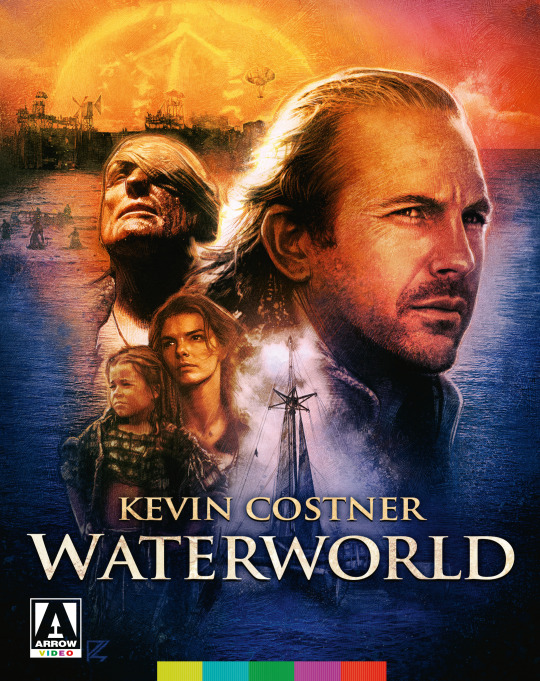
Waterworld will be released on 4K Ultra HD on June 27 via Arrow Video. Paul Shipper designed the new cover art for the 1995 post-apocalyptic sci-fi action film; the original poster will be on the reverse side.
Kevin Reynolds (Robin Hood: Prince of Thieves) directs from a script by David Twohy (The Fugitive) and Peter Rader (Escape to Witch Mountain). Kevin Costner, Dennis Hopper, Jeanne Tripplehorn, Tina Majorino, and Michael Jeter star.
The three-disc limited edition includes three version of the film - the theatrical cut on 4K UHD in Dolby Vision (HDR10 compatible), the extended TV cut on Blu-ray, and the European “Ulysses” cut on Blu-ray - all newly restored from original film elements.
Other contents include a six postcards, a double-sided poster, a 60-page book featuring writing by David J. Moore and Daniel Griffith plus archival articles. Special features are listed below.

Disc 1 - 4K UHD:
Theatrical cut with Dolby Atmos, 5.1 DTS-HD Master Audio and 2.0 stereo audio options
Maelstrom: The Odyssey of Waterworld – 2018 feature-length documentary with cast and crew
Dances with Waves – Original making-of featurette
Global Warnings – Film critic Glenn Kenny ecologically themed end-of-the-world films
Production and promotional still gallery
Visual effects still gallery
Trailers
TV spots
Disc 2 - Blu-ray:
TV cut with original 5.1 DTS-HD Master Audio and 2.0 stereo audio options
Disc 3 - Blu-ray:
Ulysses cut with original 5.1 DTS-HD Master Audio and 2.0 stereo audio options
Also included:
6 postcards
Double-sided fold-out poster
60-page perfect-bound book with writing by David J. Moore and Daniel Griffith and archival articles
Waterworld stars Kevin Costner as The Mariner – a mutant trader, adrift in a dystopian future where Earth is submerged under water and humankind struggles to survive on boats and in ramshackle floating cities. The Mariner becomes embroiled with the Smokers, a gang of pirates who, led by villainous leader Deacon (Dennis Hopper), are seeking Enola (Tina Majorino), a girl with a map to the mythical realm of Dryland tattooed on her back.
#waterworld#kevin costner#90s movies#1990s movies#dennis hopper#jeanne tripplehorn#tina majorino#michael jeter#arrow video#dvd#barry gifford#david twohy#paul shipper#kevin reynolds
19 notes
·
View notes
Text




youtube
Ulysses: A Dark Odyssey (2018)
My rating: 4/10
So this is a half-baked attempt at retelling the Odyssey as a sort of neo-noir psychological action thriller, set in a particularly silly dystopia (as far as I understand the news snippets in the beginning, the refugee crisis caused European society to collapse until the US came and Liberated (TM) us? Which is just stupid on so, so many levels) and it works about as well as can be expected, which is not very. Sure has a lot of concepts though.
#Ulysses: A Dark Odyssey#Federico Alotto#Andrea Zirio#Danny Glover#Udo Kier#Anamaria Marinca#Youtube
1 note
·
View note
Text
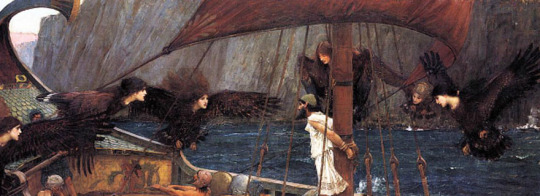
"When the history of the earth enters a very critical period, as at present, the myths, gods and demons that direct us, the Archetypes, come to take an even more active part, becoming almost visible to many. They participate directly in the combat".
- Miguel Serrano.
#miguel serrano#kali yuga#archetypes#carl jung#myth#european mythology#collective unconscious#odyssey#Ulysses#Odysseus#europe#tradition#julius evola#traditionalism#consciousness#hermeticism#the hermetic circle#Chile
41 notes
·
View notes
Text
It's really odd to see people devaluing fanfiction for being derivative work when I study European literature in college
About half of all the shit in the Renaissance is Greek and Roman mythology fanfic with a coat of Christianity on top but you don't see people saying that the Divine Comedy doesn't have any value just because it's derivative work
Lost Paradise is Biblie fanfiction starring sexy Satan
Faust is part of a long tradition of RPF fic featuring the same German alchemist
A bunch of Shakespeare's plays are inspired from different stories and poems
Dante and Petrarca have written RPF of living breathing women just because they couldn't boink them and that's considered high literature
The Decameron has been adapted so much you can find at least 5 poems inspired by every story in it (a bit of an exageration but you get my point)
Ulysses is just The Odyssey fanfic
The entire canon or King Arthur and Robin Hood is just people adapting other people's works and adding whatever shit they liked
"But now people are making porn of it"
And you think people in the past didn't want to fuck Child Harold or Lord Ruthven? Of course they did, they just couldn't say it publicly. Not everyone was John Cleland
12 notes
·
View notes
Note
Do you think Sansa can be described as 'Siren'?
By Siren, do you mean the half bird and half woman creature from Greek Mythology? Or by Siren, do you mean Mermaid?
Through history, both concepts have merged and that's why I think Sansa Stark is associated with both.
SIREN
Siren, in Greek mythology, a creature half bird and half woman who lured sailors to destruction by the sweetness of her song.
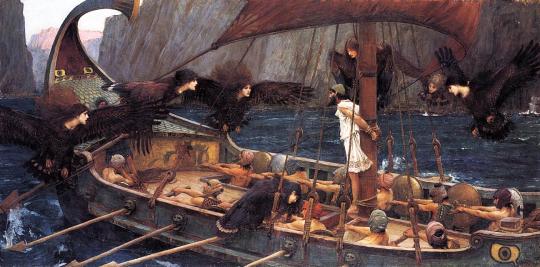
Art credit: Ulysses and the Sirens by John William Waterhouse
In Homer’s Odyssey, Book XII, the Greek hero Odysseus, advised by the sorceress Circe, escaped the danger of their song by stopping the ears of his crew with wax so that they were deaf to the Sirens. Odysseus himself wanted to hear their song but had himself tied to the mast so that he would not be able to steer the ship off its course.
“Friends, it’s wrong for only one or two to know the revelations that lovely Circe made to me alone. I’ll tell you all, so we can die with our eyes wide open now or escape our fate and certain death together. First, she warns, we must steer clear of the Sirens, their enchanting song, their meadow starred with flowers. I alone was to hear their voices, so she said, but you must bind me with tight chafing ropes so I cannot move a muscle, bound to the spot, erect at the mast-block, lashed by ropes to the mast. And if I plead, commanding you to set me free, then lash me faster, rope on pressing rope.”
[...] We were just offshore as far as a man’s shout can carry, scudding close, when the Sirens sense at once a ship was racing past and burst into their high, thrilling song: “Come closer, famous Odysseus—Achaea’s pride and glory— moor your ship on our coast so you can hear our song! Never has any sailor passed our shores in his black craft until he has heard the honeyed voices pouring from our lips, and once he hears to his heart’s content sails on, a wiser man.
—Odyssey, Book XII - Homer
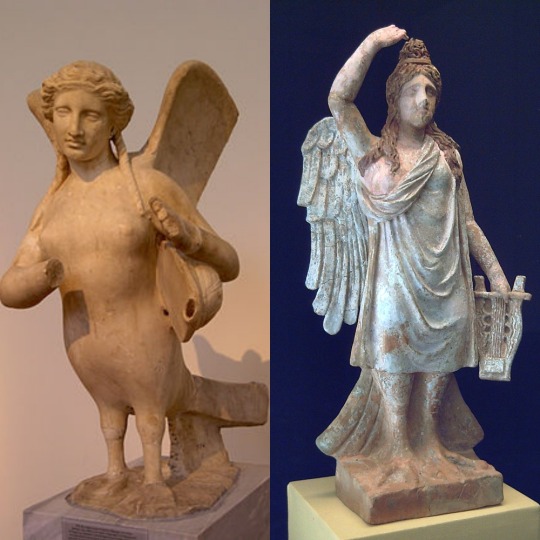
Sirens were believed to look like a combination of women and birds in various different forms. In early Greek art, they were represented as birds with large women's heads, bird feathers and scaly feet. Later, they were represented as female figures with the legs of birds, with or without wings, playing a variety of musical instruments, especially harps and lyres.
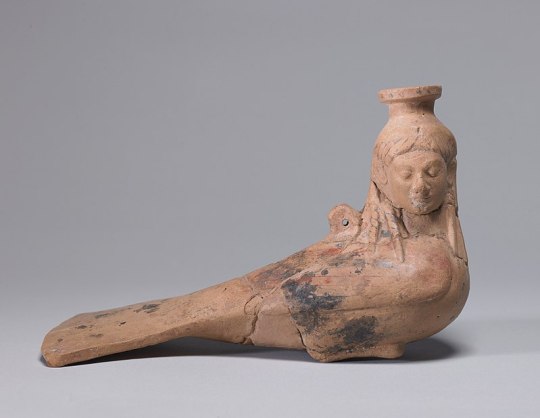
The tenth-century Byzantine encyclopedia Suda says that from their chests up, sirens had the form of sparrows, and below they were women or, alternatively, that they were little birds with women's faces.
* * *
As you can see, we could find many allusions to sirens in Sansa Stark:
Siren: Half bird and half woman & Sansa: little bird, mockingbird.
Siren: Sweetness of her song / Honeyed voices & Sansa: "So the singer played for her, so soft and sad that Arya only heard snatches of the words, though the tune was half-familiar. Sansa would know it, I bet. Her sister had known all the songs, and she could even play a little, and sing so sweetly. All I could ever do was shout the words." —A Storm of Swords - Arya IV
Siren: Lures sailors to drown & Sansa: "You have your mother's eyes. Honest eyes, and innocent. Blue as a sunlit sea. When you are a little older, many a man will drown in those eyes." —A Feast for Crows - Sansa I
Siren: Harps and lyres & Sansa: "Sansa could sew and dance and sing. She wrote poetry. She knew how to dress. She played the high harp and the bells." —A Game of Thrones - Arya I
Siren: Lives in flowery meadows & Sansa: Linked with flowers and certain meadow.
Siren: Represented as little birds /sparrows & Sansa: little bird, mockingbird.
MERMAID
Mermaids are also called Sirens. Sirena is the Spanish word for Mermaid.
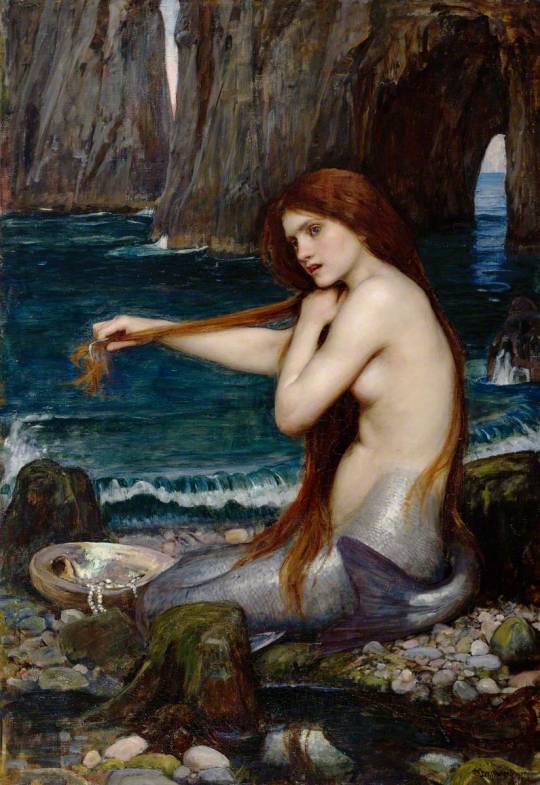
Art credit: A Mermaid by John William Waterhouse
Mermaid, masculine merman, a fabled marine creature with the head and upper body of a human being and the tail of a fish. Similar divine or semidivine beings appear in ancient mythologies (e.g., the Chaldean sea god Ea, or Oannes). In European folklore, mermaids (sometimes called sirens) and mermen were natural beings who, like fairies, had magical and prophetic powers. They loved music and often sang. Though very long-lived, they were mortal and had no souls.
Though sometimes kindly, mermaids and mermen were usually dangerous to man. Their gifts brought misfortune, and, if offended, the beings caused floods or other disasters. To see one on a voyage was an omen of shipwreck. They sometimes lured mortals to death by drowning, as did the Lorelei of the Rhine, or enticed young people to live with them underwater, as did the mermaid whose image is carved on a bench in the church of Zennor, Cornwall, England.
THE LITTLE MERMAID
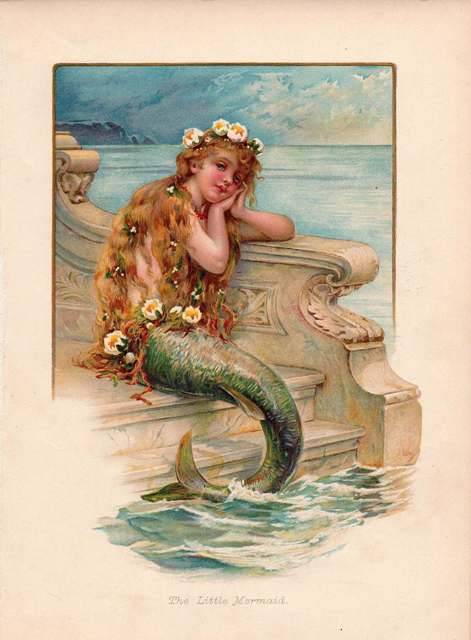
Art credit: Illustration of The Little Mermaid, mid-19th century, by E. S. Hardy.
Probably the most famous mermaid in popular culture is Hans Christian Andersen's The Little Mermaid.
Reading the Danish fairy tale, it's almost impossible not to draw parallels between The Little Mermaid and Sansa Stark, both so avid to leave their homes to see a new world and find love.
Both girls are young, beautiful, romantics, possess beautiful voices and are full of gentleness and kindness.
You can also find sad parallels, like this one explained by@mryoyo000
Hans Christian Andersen's The Little Mermaid has a bittersweet ending as our heroine fails to make the prince fall in love with her and witnesses his wedding to another girl.
The Little Mermaid then resigned herself to die and become sea foam, but at the very end she is rewarded for her kindness.
If you are interested, you can read The Little Mermaid here.
APHRODITE
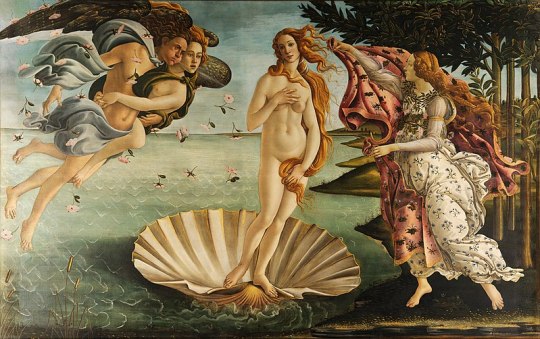
Art credit: La nascita di Venere by Sandro Botticelli
Let's make a little stop here to talk about Aphrodite.
Aphrodite is neither a mermaid nor a siren, she is an Ancient Greek Goddess, born from the froth of the sea:
Aphrodite, ancient Greek goddess of sexual love and beauty, identified with Venus by the Romans. The Greek word aphros means “foam,” and Hesiod relates in his Theogony that Aphrodite was born from the white foam produced by the severed genitals of Uranus (Heaven), after his son Cronus threw them into the sea.
As you can see, both in the myth of Aphrodite and in the tale of The Little Mermaid, the froth of the sea has a determining importance, meaning life and death:
The Birth of Aphrodite The genitalia themselves, freshly cut with flint, were thrown Clear of the mainland into the restless, white-capped sea, Where they floated a long time. A white foam from the god-flesh Collected around them, and in that foam a maiden developed And grew. Her first approach to land was near holy Cythera, And from there she floated on to the island of Cypros. There she came ashore, an awesome, beautiful divinity. Tender grass sprouted up under her slender feet. Aphrodite Is her name in speech human and divine, since it was in foam She was nourished. But she is also called Cythereia since She reached Cythera, and Cyprogenes because she was born On the surf-line of Cypros, and Philommedes because she loves The organs of sex, from which she made her epiphany. Eros became her companion, and ravishing Desire waited on her At her birth and when she made her debut among the Immortals. From that moment on, among both gods and humans, She has fulfilled the honored function that includes Virginal sweet-talk, lovers’ smiles and deceits, And all of the gentle pleasures of sex. —Theogony - Hesiod
"We can live until we are three hundred years old, but when we cease to exist, we become foam on the water, do not even have a grave down here among our dear ones. We do not have an immortal soul, we will never live again, we are like the green rushes, once they have been severed they can never grow green again!"
—The Little Mermaid - Hans Christian Andersen
Here we need to remember that the Freys dump her (Catelyn) body naked into the Green Fork, a mockery of House Tully's funeral customs, after Catelyn has been dead for a day and a night. Three days after her death, Catelyn's corpse is retrieved from the Green Fork by Arya Stark's direwolf, Nymeria, who runs away when humans approach. Catelyn is resurrected by Lord Beric Dondarrion, who gives his life for hers through the last kiss.
We also have the Ironborn Ritual Drowning. The priests of the Drowned God know how to drown a man and then bring him back to life, using the kiss of life. This is done as part of the rites of the god, consecrating the drowned person to him. Not all men are successfully revived, however. While the priest or one of his acolytes uses the kiss of life on the drowned man, other acolytes might pray around them. It is custom to give a newborn child to the Drowned God shortly following his birth. Some priests believe that this should be done in a similar manner, but more frequently the child is simply dipped into a tub of seawater to wet the infant's head.
Also, if you check the multiple representations of Aphrodite in art, she is clearly depicted as a mermaid, with floating long hair (often red), emerging from the sea foam, carried in a giant shell, surrounded by sea creatures, etc.
JONQUIL
“Six maids there were in a spring-fed pool …”
—A Storm of Swords - Jaime III
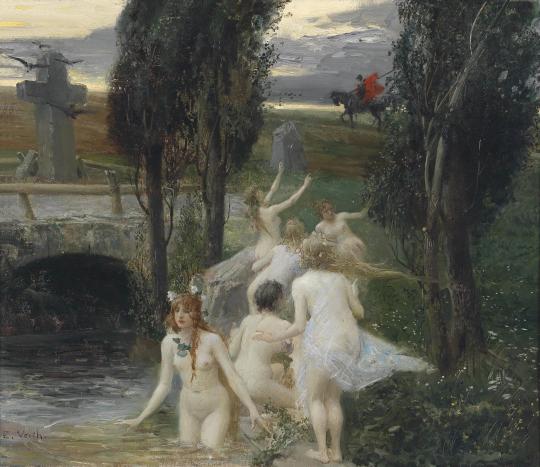
Art credit: Nereiden by Eduard Veith
And talking about mermaids and ancient goddesses, bodies of water and beautiful naked ladies coming from said bodies of water, all of that reminds me of the tales about Jonquil bathing in a sweet water pool (Maidenpool) at the Riverlands.
So Jonquil is surrounded by Mermaid/Aphrodite aesthetic.
And fair Jonquil reminds me of certain girl from the maternal line of House Tully, half fish, with long auburn hair and sunlit blue eyes....
Anyways, now lets go back to mermaids.
DISNEY'S THE LITTLE MERMAID
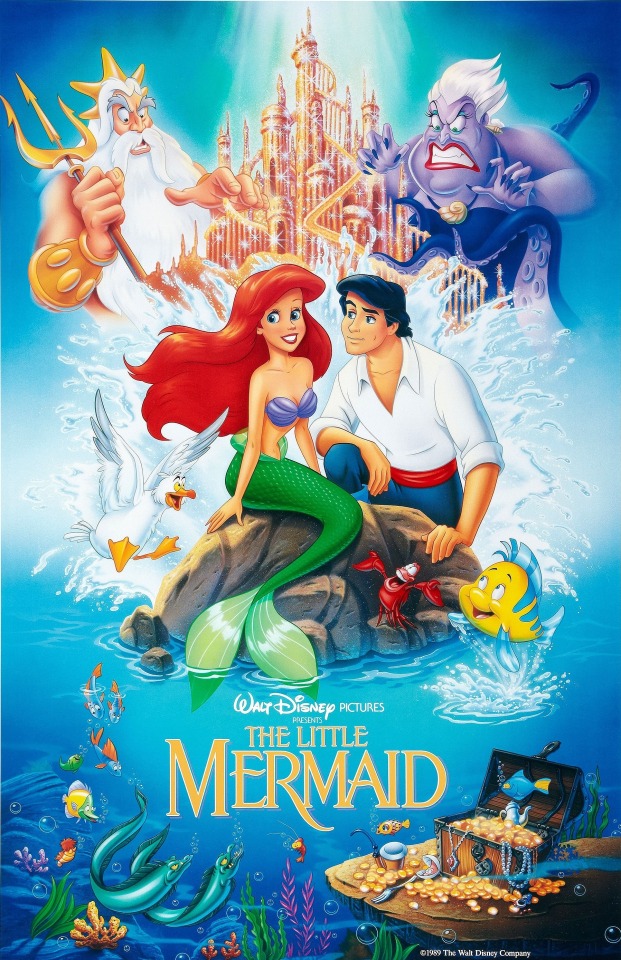
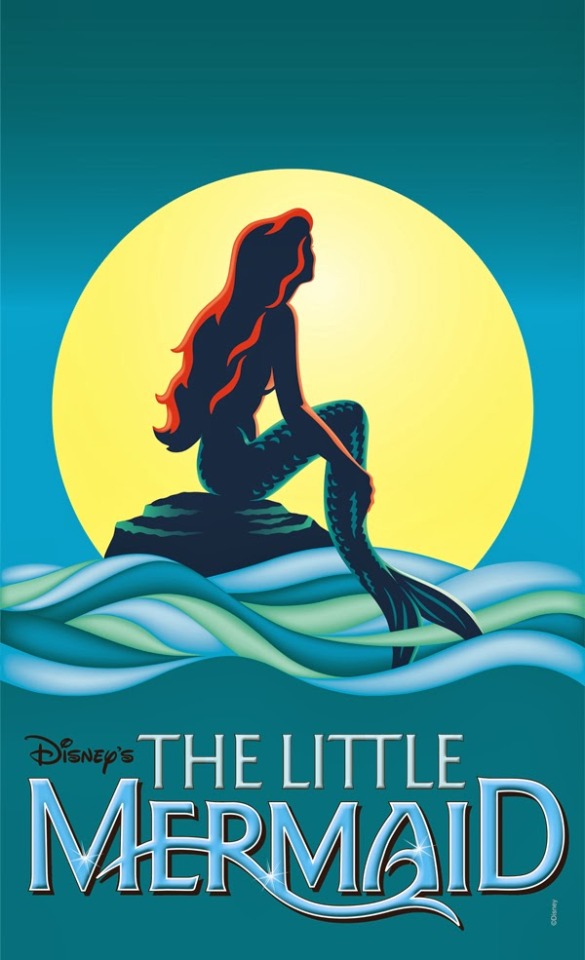
Pictures credit: Disney's The Little Mermaid
Disney's animated version of The Little Mermaid changed the bittersweet ending of the original tale by giving to our heroine Ariel the fulfillment of her love story with her beloved prince Eric.
You can find a very sweet parallel between Sansa, Jon, Ariel and Eric, here.
Now, we all know that Jean Cocteau's La Belle et la Bête (based in one of the first versions of the fairy tale), is one of GRRM's favorite films, but the author has said that he likes Disney's The Little Mermaid even more than Disney's Beauty and the Beast:

GRRM is also very aware of Hans Christian Andersen's The Little Mermaid and it's bittersweet ending:
WELT: Again: We know what will happen to the Mother of Dragons. How do you want to surpass that in a novel – with an alternative literary version?
GRRM: Counter question: How many children did Scarlett O'Hara have? In Margaret Mitchell’s novel “Gone with the Wind” she had three children. But in the cinema version of the novels she only had one child. Which version is the only one valid - the one with one or the other with three children? The answer is: neither. Because Scarlett O'Hara never existed, she is a fictional character, not a real person, who would have had real children. Or take “The Little Mermaid”. We know her from the fairytale of the same name by Hans Christian Andersen and from the Disney movie. Which one is the true mermaid? Well, mermaids do not exist. So you can chose the version that you personally like the best. Changes are inevitable in this process. Even if the adaption is as faithful to the literary source material as it was the case with “Game of Thrones”.
—GEORGE R. R. MARTIN “Die Leute kennen ein Ende – nicht das Ende” - WELT 2020 - (Translation)
With all that said, now lets see for direct references of mermaids in ASOIAF.
MERMAIDS AND ASOIAF
Merlings are legendary aquatic creatures with the upper body of a human and the tail of a fish. Merfolk include mermen, merwives, and mermaids.
Mermaids are featured in Westerosi carvings, place names, and in songs. They are often featured in places near the sea, such as White Harbor.
The sigil of House Manderly of White Harbor is a white merman with dark green hair, beard and tail, carrying a black trident, over a blue-green field.
The Merling King is a Braavosi trading galley. Its figurehead is a golden-crowned merman blowing on a seashell horn.
The Merling King comes to King's Landing after the Battle of the Blackwater. There it is hired by Lord Petyr Baelish to take him to the Eyrie to wed the widowed Lady Lysa Arryn. Petyr and Sansa Stark flee on the galley after the death of King Joffrey I Baratheon at his royal wedding. Their voyage north is dangerous, as two men are swept overboard and a third breaks his neck. After putting Petyr and Sansa Stark ashore at the Fingers, the Merling King sets sail for Braavos.
Off the bow of the Merling King stretched a bare and stony strand, windswept, treeless, and uninviting. Even so, it made a welcome sight. They had been a long while clawing their way back on course. The last storm had swept them out of sight of land, and sent such waves crashing over the sides of the galley that Sansa had been certain they were all going to drown. Two men had been swept overboard, she had heard old Oswell saying, and another had fallen from the mast and broken his neck.
[...] That night Sansa scarcely slept at all, but tossed and turned just as she had aboard the Merling King.
—A Storm of Swords - Sansa VI
Are you telling me that our Little Mermaid Sansa Stark sailed on a ship called the Merling King??? And when she disembarked at the Fingers, she became Alayne Stone??? Like a death and a birth after crossing the sea??? Like the sea foam meaning death and life in myth and folklore??? Interesting....
And finally, this passage could be a homage to Disney's The Little Mermaid:
The last of the Bronze Kings was Yorwyck’s grandson, Robar II, who inherited Runestone from his sire less than a fortnight before his sixteenth nameday yet proved to be a warrior of such ferocity and cunning and charm that he almost succeeded in stemming the Andal tide.
By that time the Andals controlled threequarters of the Vale and had begun to fight amongst themselves, as had the First Men before them. Robar Royce saw opportunity in their disunity. Across the Vale, a handful of First Men still held out against the Andals; the Redforts of Redfort, the Hunters of Longbow Hall, the Belmores of Strongsong, and the Coldwaters of Coldwater Burn chief amongst them. One by one, Robar made alliance with each of them, and many smaller clans and houses besides, bringing them to his cause with marriages, grants of land, gold, and (in one celebrated case) by outshooting the Lord Hunter in an archery contest (legend claims that King Robar cheated). So honeyed was his tongue that he even won the allegiance of Ursula Upcliff, a reputed sorceress who called herself bride of the Merling King.
—The World of Ice and Fire - The Vale
A sorceress named Ursula??? Bride of the Merling King??? Oh George, you adorable nerd.
* * *
As you can see, we could find many allusions to mermaids in Sansa Stark:
Mermaid: Half fish and half woman & Sansa: House Tully / half fish.
Mermaid: Often depicted with red hair & Sansa: Tully auburn hair.
Mermaid: Lures mortals to death by drowning & Sansa: "You have your mother's eyes. Honest eyes, and innocent. Blue as a sunlit sea. When you are a little older, many a man will drown in those eyes." —A Feast for Crows - Sansa I
Mermaid: Likes fairies, had magical and prophetic powers. Loves music and often sings & Sansa: Loves fairy tales, her dreams come true, is the protagonist of multiple prophecies, loves music and sings.
Mermaid: In Myth (Aphrodite) and Folklore (The Little Mermaid) the sea foam means life and death & Sansa: After sailing on a ship called "The Merling King (Merman)," Sansa disembarked at the fingers and became Alayne Stone.
Mermaid: A marine creature, often depicted half naked (their human half) & Sansa: Descendant from House Tully of the Riverlands, which sigil is a trout, whose members are colloquially called half fish. Sansa's favorite stories are the ones that involve fair Jonquil, who according to the tales was seen bathing (probably naked) in a sweet water pool (Maidenpool) at the Riverlands (Mermaid/Aphrodite aesthetic).
There you have it! And this post is already too long....
Thanks for your message :)
#anon asks#sansa stark#the little mermaid#the birth of venus#aphordite#sirens#mermaids#fairy tales#greek mythology#folklore
174 notes
·
View notes
Text

Unspoiled Calabria, the hidden gem of Southern Italy
One of the most neglected destinations in Italy is Calabria, the "toe" of the boot. But things are changing as tourists discover the remarkable beauty of the rugged hill towns, Mediterranean influenced cuisine and travel bargains the south affords. Greek influences are felt here and a dialect of the language is still spoken in some areas.
In summer the little lanes that run through the towns and the beautiful beaches on the Tyrrhenian and Ionian Seas get a lot of European tourists and recently Americans have been discovering their charms.

With more and more restaurants in America featuring the tasty foods of Calabria, gastronomic tourism is becoming more important as well. Cuisine changes with the land in this area, depending on what the earth provides and tradition demands.
The stigma thrust on the south by the wealthier north as a land of peasants, has preserved the area and its agricultural economy and the new rush of tourism is bringing money and new self-esteem to its inhabitants. Many Americans trace their family roots to this part of Italy; where over the last 150 years poverty and internecine warfare forced Italians to leave the “old Country,” fleeing to America.

Lying on the tip of the toe, Calabria offers dramatic landscapes as you cross from the Ionian Sea on the south over the high Apennine ridge, where you can encounter snow in winter, and descend to the Tyrrhenian Sea side and view the steep coastline that shelters little fishing villages, like Scilla and Bagnara.
Scilla is a unique spot that CNN added to its list of the most beautiful villages in Italy, a seaside tourist destination capable of attracting writers, poets and artists from all over the world.

The origins of Scilla are linked to Greek mythology. Legend has it that Scylla, an extraordinarily beautiful nymph, was transformed by the sorceress Circe, her rival in love, into a frightful sea monster with six dog-heads. From that moment on Scylla lived in the Strait of Messina, on the opposite side from the Sicilian monster Charybdis, and as soon as she saw sailors coming close to her side, she would devour them without mercy.
In Homer’s Odyssey, Ulysses is warned of the dangers of the two by the sorceress Circe.

The seaside resort town of Crotone is one of the oldest cities of Europe. Founded by the ancient Greeks in 710 BC, it was for a long time one of the most flourishing cities of Magna Graecia, name given by the Romans to the Greek colonies of Southern Italy.
The city of Reggio Calabria is the largest in the area and is home to the most important Archaeological Museum dedicated to Magna Graecia of the entire Italian peninsula. Inside the Museum there are the very famous Riace Bronzes. The two statues, found on August 16, 1972 near Riace, in the province of Reggio Calabria, are considered among the most significant sculptural masterpieces of Greek art, and among the direct testimonies of the great master sculptors of the classical age.
Reggio Calabria has a lovely promenade facing the Strait of Messina that many consider the most beautiful in Italy. Just two and a half miles across the Strait is the island of Sicily.

Follow us on Instagram, @calabria_mediterranea
#calabria#italy#italia#italian#south italy#southern italy#mediterranean#europe#mediterranean sea#sea#italian landscapes#italian landscape#landscapes#landscape#medieval#art#history#italy destinations#tourism#gerace#crotone#reggio calabria#sicily#scilla#flowers#nature#greek mythology#mythology#odyssey#ulysses
61 notes
·
View notes
Text
Ulysses European Odyssey

ULYSSES European Odyssey (UEO) is an epic project from 2022-2024 across 18 cities in 16 countries, producing artistic responses in public spaces to social and cultural themes identified in the 18 episodes of James Joyce’s Ulysses. At the same time, a cycle of 18 public symposia will be held in each city to produce 309 questions (Ulysses, Episode 17) towards creating a new arts and society charter for Europe. The project also has 30 artist residencies which will contribute to a new book, Europe-Ulysses (working title), alongside 18 new writing commissions, one writer from each city.
UEO consists of a new European network of 18 partners co-producing a single public project comprising 3 Acts of 18 scenes from 2022-24 across public spaces in 18 European cities of 16 different countries – Athens, Trieste, Vilnius, Gyanógeregye, Marseille, Paris, Berlin, Lugo, Copenhagen, Istanbul, Cluj, Zurich, Leeuwarden, Eleusis, Oulu, Lisbon, Dublin & Derry/Donegal.
-------------------------------------------------------------
Madame Vera Verity a Női Szépség Rovat vezetője volt a Princess Novelette folyóiratban, s ilyen minőségében joggal hivatkozik rá Joyce az Ulysses-ben. Egyébként neki volt egy kései és elég távoli, magyarországi - Vas megyei - rokona, özv. Dr. Verity Béláné. Kevésbé ismert, hogy ő találta ki az 1989-es gyanógeregyei Bloomsday-t, mely Pannóniában minden továbbinak az ötletadója volt. Ennek tükrében igen nagy öröm, hogy az EU Ulysses European Odyssey 2022-2024 /UEO/ elnevezésű projektjében Magyarországot ez a pici, de a 'bloomság' szempontjából különösen nagy jelentőségű, nyugat-dunántúli kisközség képviseli. Az UEO egy 2022 és 2024 között megvalósuló nagy, európai közös munka, amely egyidejűleg 16 ország 18 településén zajlik, és publikus tereken művészi válaszokat ad az Ulysses 18 fejezetében meghatározott társadalmi és kulturális témákra. Ezzel párhuzamosan a 18 helyszínen nyilvános szimpóziumot tartanak, amelynek keretében /az Ulysses 17. fejezetére utalva/ összesen 309 kérdést tesznek fel egy új európai művészeti és társadalmi charta megalkotása érdekében. A projektben részt velő művészek aktivitásukkal hozzájárulnak egy új könyv elkészítéséhez /munkacím: Európa-Ulysses/. Az UEO projektet 18 partnerből álló, új, európai hálózat alkotja. A résztvevők egyetlen, nyilvános és közös, 3 felvonásból és 18 jelenetből álló alkotást készítenek, amely 2022-24 között 16 különböző ország 18 európai településén – Athénban, Triesztben, Vilniusban, Gyanógeregyén, Marseille-ben, Párizsban, Berlinben, Lugo-ban, Koppenhágában, Isztambulban, Kolozsvárott, Zürich-ben, Leeuwarden-ben, Eléfszinában, Oulu-ban, Lisszabonban, Dublinban és Derry/Donegal-ban – valósul meg. Joyce az Ulysses 18 fejezetéhez egy-egy színt javasolt. Mivel a projektben részt vevő európai települések művészi eszközökkel az Ulysses adott, konkrét fejezetére reflektálnak, így a partnerek saját, megkülönböztető színe összességében adja ki a joyce-i alapon is értelmezhető sokszínűséget. Gyanógeregyéé a negyedik, Kalüpszó című fejezet, a színe pedig a zöld.
0 notes
Text

Ulysses and the Sirens by John William Waterhouse
#john william waterhouse#art#ulysses#sirens#odysseus#the odyssey#homer#ancient greece#ancient greek#classical antiquity#greek mythology#ship#ships#europe#european#mediterranean#sea#sailing
120 notes
·
View notes
Text
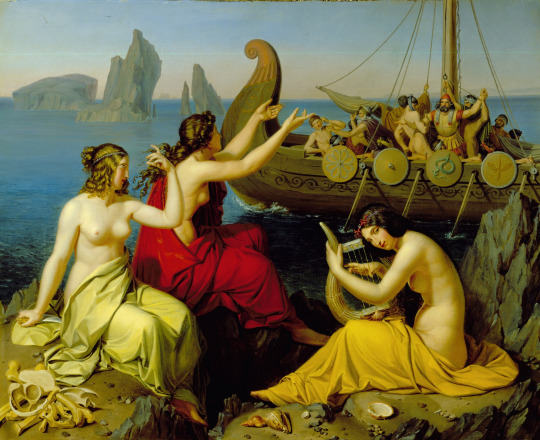
Alexander Bruckmann (German, 1806-1852) Odysseus und die Sirenen, 1829 Staatsgalerie Stuttgart
#Alexander Bruckmann#German art#Odysseus und die Sirenen#1800s#art#fine art#european art#classical art#europe#european#fine arts#oil painting#1800s art#europa#mediterranean#blonde redhead brunette art trope#blonde#redhead#brunette#women#female#woman#mythological art#the odyssey#ulysses
71 notes
·
View notes
Note
How do you personally feel about the use of Greek culture in manga/anime such as Sailor moon, Saint Seiya or Ulysses 31?
For me, and for most Greeks I think, there is no issue. It would be a bit nicer if, in general, manga and anime went deeper into the culture (because, from what I know at least, it's a bit superficial. Mostly 2-3 broad elements) and I would also like to see some less popular myths. The popular myths are pretty known already and used frequently, so a change would be refreshing. But don't get me wrong, the creators make the elements look pretty cool!
I think Greeks don't mind it when East Asians adapt myths, do retellings or have Greek mythology elements in manga and anime because we know the root of all this is excitement and passion and there is no connection to the imperial and colonizing mindset Greece had to face in Europe the last centuries. Japanese are just like "oooh look how cool!" and a lot of times they put their passion in their projects and the results are usually nice, with the Greek and Japanese elements mixing well.
(Many Europeans have done this well, I don't doubt, but it's the Japanese we are talking about now).
I don't know or remember much but I think Ulysses 31 (We call it "Space Odyssey 31" - Οδύσσεια του διαστήματος 31 - here) had many and interesting references, it was a retelling of shorts. And also had a crossover with the ancient, "real" Odysseus! I wish I had seen more episodes. Saint Seiya also seems to have a satisfactory amount of Greek elements in (enough elements to not make the myths look out of place or strip them entirely of their culture). I haven't watched the anime so I don't know for sure.
I think Greek kids and teens like the existence of Greek mythology into media from different countries (I don't remember how I felt xD) but as you grow up you have seen enough Greek mythology to sustain you for 5 centuries xD So that's why I'd like some change in my old theitsa-age 😂
19 notes
·
View notes